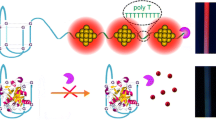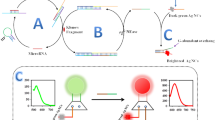Abstract
A fluorometric method is described for nucleic acid signal amplification through target-induced catalytic hairpin assembly with DNA-templated copper nanoparticles (Cu NPs). The toehold-mediated self-assembly of three metastable hairpins is triggered in presence of target DNA. This leads to the formation of a three-way junction structure with protruding mononucleotides at the 3′ terminus. The target DNA is released from the formed branched structure and triggers another assembly cycle. As a result, plenty of branched DNA becomes available for the synthesis of Cu NPs which have fluorescence excitation/emission maxima at 340/590 nm. At the same time, the branched structure protects the Cu NPs from digestion by exonuclease III. The unreacted hairpins are digested by exonuclease III, and this warrants a lower background signal. The method can detect ssDNA (24 nt) at low concentration (44 pM) and is selective over single-nucleotide polymorphism. On addition of an aptamer, the strategy can also be applied to the quantitation of thrombin at levels as low as 0.9 nM.

Schematic representation of target-induced catalytic hairpin assembly to form branched DNA template for the in situ synthesis of fluorescent Cu nanoparticles.





Similar content being viewed by others
References
Li J, Green AA, Yan H, Fan C (2017) Engineering nucleic acid structures for programmable molecular circuitry and intracellular biocomputation. Nat Chem 9(11):1056–1067. https://doi.org/10.1038/nchem.2852
Chen YJ, Groves B, Muscat RA, Seelig G (2015) DNA nanotechnology from the test tube to the cell. Nat Nanotechnol 10(9):748–760. https://doi.org/10.1038/nnano.2015.195
Yang D, Tang Y, Miao P (2017) Hybridization chain reaction directed DNA superstructures assembly for biosensing applications. TrAC Trends Anal Chem 94:1–13. https://doi.org/10.1016/j.trac.2017.06.011
Bi S, Yue S, Zhang S (2017) Hybridization chain reaction: a versatile molecular tool for biosensing, bioimaging, and biomedicine. Chem Soc Rev 46(14):4281–4298. https://doi.org/10.1039/c7cs00055c
Yang F, Zuo X, Fan C, Zhang X-E (2018) Biomacromolecular nanostructures-based interfacial engineering: from precise assembly to precision biosensing. Natl Sci Rev 5(5):740–755. https://doi.org/10.1093/nsr/nwx134
Chen Z, Liu C, Cao F, Ren J, Qu X (2018) DNA metallization: principles, methods, structures, and applications. Chem Soc Rev 47(11):4017–4072. https://doi.org/10.1039/c8cs00011e
Chen Y, Phipps ML, Werner JH, Chakraborty S, Martinez JS (2018) DNA Templated metal Nanoclusters: from emergent properties to unique applications. Acc Chem Res 51(11):2756–2763. https://doi.org/10.1021/acs.accounts.8b00366
New SY, Lee ST, Su XD (2016) DNA-templated silver nanoclusters: structural correlation and fluorescence modulation. Nanoscale 8(41):17729–17746. https://doi.org/10.1039/c6nr05872h
Lee JB, Roh YH, Um SH, Funabashi H, Cheng W, Cha JJ, Kiatwuthinon P, Muller DA, Luo D (2009) Multifunctional nanoarchitectures from DNA-based ABC monomers. Nat Nanotechnol 4(7):430–436. https://doi.org/10.1038/nnano.2009.93
Meng HM, Zhang X, Lv Y, Zhao Z, Wang NN, Fu T, Fan H, Liang H, Qiu L, Zhu G, Tan W (2014) DNA dendrimer: an efficient nanocarrier of functional nucleic acids for intracellular molecular sensing. ACS Nano 8(6):6171–6181. https://doi.org/10.1021/nn5015962
Schultz D, Gardner K, Oemrawsingh SS, Markesevic N, Olsson K, Debord M, Bouwmeester D, Gwinn E (2013) Evidence for rod-shaped DNA-stabilized silver nanocluster emitters. Adv Mater 25(20):2797–2803. https://doi.org/10.1002/adma.201204624
Park J, Song J, Park J, Park N, Kim S (2014) Branched DNA-based synthesis of fluorescent silver Nanocluster. Bull Kor Chem Soc 35(4):1105–1109. https://doi.org/10.5012/bkcs.2014.35.4.1105
Guo W, Orbach R, Mironi-Harpaz I, Seliktar D, Willner I (2013) Fluorescent DNA hydrogels composed of nucleic acid-stabilized silver nanoclusters. Small 9(22):3748–3752. https://doi.org/10.1002/smll.201300055
Yang L, Yao C, Li F, Dong Y, Zhang Z, Yang D (2018) Synthesis of branched DNA Scaffolded Super-Nanoclusters with enhanced antibacterial performance. Small 14(16):e1800185. https://doi.org/10.1002/smll.201800185
Qing Z, He X, Huang J, Wang K, Zou Z, Qing T, Mao Z, Shi H, He D (2014) Target-catalyzed dynamic assembly-based pyrene excimer switching for enzyme-free nucleic acid amplified detection. Anal Chem 86(10):4934–4939. https://doi.org/10.1021/ac500834g
Wang H, Li C, Liu X, Zhou X, Wang F (2018) Construction of an enzyme-free concatenated DNA circuit for signal amplification and intracellular imaging. Chem Sci 9(26):5842–5849. https://doi.org/10.1039/c8sc01981a
Chen L, Sha L, Qiu Y, Wang G, Jiang H, Zhang X (2015) An amplified electrochemical aptasensor based on hybridization chain reactions and catalysis of silver nanoclusters. Nanoscale 7(7):3300–3308. https://doi.org/10.1039/c4nr06664b
Yang C, Shi K, Dou B, Xiang Y, Chai Y, Yuan R (2015) In situ DNA-templated synthesis of silver nanoclusters for ultrasensitive and label-free electrochemical detection of microRNA. ACS Appl Mater Interfaces 7(2):1188–1193. https://doi.org/10.1021/am506933r
Orbach R, Guo W, Wang F, Lioubashevski O, Willner I (2013) Self-assembly of luminescent Ag nanocluster-functionalized nanowires. Langmuir 29(42):13066–13071. https://doi.org/10.1021/la402888b
Liu R, Wang C, Hu J, Su Y, Lv Y (2018) DNA-templated copper nanoparticles: versatile platform for label-free bioassays. TrAC Trends Anal Chem 105:436–452. https://doi.org/10.1016/j.trac.2018.06.003
Han Y, Zhang F, Gong H, Cai C (2018) Double G-quadruplexes in a copper nanoparticle based fluorescent probe for determination of HIV genes. Microchim Acta 186(1):30. https://doi.org/10.1007/s00604-018-3119-5
Kim S, Kim JH, Kwon WY, Hwang SH, Cha BS, Kim JM, Oh SS, Park KS (2019) Synthesis of DNA-templated copper nanoparticles with enhanced fluorescence stability for cellular imaging. Microchim Acta 186(7):479–475. https://doi.org/10.1007/s00604-019-3620-5
Zhang Y, Chen Z, Tao Y, Wang Z, Ren J, Qu X (2015) Hybridization chain reaction engineered dsDNA for cu metallization: an enzyme-free platform for amplified detection of cancer cells and microRNAs. Chem Commun (Camb) 51(57):11496–11499. https://doi.org/10.1039/c5cc03144c
Song C, Yang X, Wang K, Wang Q, Huang J, Liu J, Liu W, Liu P (2014) Label-free and non-enzymatic detection of DNA based on hybridization chain reaction amplification and dsDNA-templated copper nanoparticles. Anal Chim Acta 827 (0):74–79. doi:https://doi.org/10.1016/j.aca.2014.04.006
Chen J, Zhou S (2016) Label-free DNA Y junction for bisphenol a monitoring using exonuclease III-based signal protection strategy. Biosens Bioelectron 77:277–283. https://doi.org/10.1016/j.bios.2015.09.042
Cao Q, Li J, Wang E (2019) Recent advances in the synthesis and application of copper nanomaterials based on various DNA scaffolds. Biosens Bioelectron 132:333–342. https://doi.org/10.1016/j.bios.2019.01.046
Wang Z, Y-e S, Yang X, Xiong Y, Li Y, Chen B, Lai W-F, Rogach AL (2018) Water-soluble biocompatible copolymer Hypromellose grafted chitosan able to load exogenous agents and copper Nanoclusters with aggregation-induced emission. Adv Funct Mater 28(34):1802848. https://doi.org/10.1002/adfm.201802848
Wang B, Thachuk C, Ellington AD, Winfree E, Soloveichik D (2018) Effective design principles for leakless strand displacement systems. Proc Natl Acad Sci U S A 115(52):E12182–E12191. https://doi.org/10.1073/pnas.1806859115
Zhang DY, Seelig G (2011) Dynamic DNA nanotechnology using strand-displacement reactions. Nat Chem 3(2):103–113
Xu N, Wang Q, Lei J, Liu L, Ju H (2015) Label-free triple-helix aptamer as sensing platform for “signal-on” fluorescent detection of thrombin. Talanta 132:387–391. https://doi.org/10.1016/j.talanta.2014.09.031
Li L, Liang Y, Zhao Y, Chen Z (2018) Target binding and DNA hybridization-induced gold nanoparticle aggregation for colorimetric detection of thrombin. Sensors Actuators B Chem 262:733–738. https://doi.org/10.1016/j.snb.2018.02.061
Chung S, Moon J-M, Choi J, Hwang H, Shim Y-B (2018) Magnetic force assisted electrochemical sensor for the detection of thrombin with aptamer-antibody sandwich formation. Biosens Bioelectron 117:480–486. https://doi.org/10.1016/j.bios.2018.06.068
Sui N, Wang L, Xie F, Liu F, Xiao H, Liu M, Yu WW (2016) Ultrasensitive aptamer-based thrombin assay based on metal enhanced fluorescence resonance energy transfer. Microchim Acta 183(5):1563–1570. https://doi.org/10.1007/s00604-016-1774-y
Khonsari YN, Sun S (2018) Electrochemiluminescent aptasensor for thrombin using nitrogen-doped graphene quantum dots. Microchim Acta 185(9):430–410. https://doi.org/10.1007/s00604-018-2942-z
Wang L, Yang W, Li T, Li D, Cui Z, Wang Y, Ji S, Song Q, Shu C, Ding L (2017) Colorimetric determination of thrombin by exploiting a triple enzyme-mimetic activity and dual-aptamer strategy. Microchim Acta 184(9):3145–3151. https://doi.org/10.1007/s00604-017-2327-8
Acknowledgments
This work was financially supported by National Natural Science Foundation of China (31801636), National Key Research and Development Program of China (2017YFC1600603),, and Shanghai Sailing Program (Grant No. 18YF1417300).
Author information
Authors and Affiliations
Corresponding author
Additional information
Publisher’s note
Springer Nature remains neutral with regard to jurisdictional claims in published maps and institutional affiliations.
Electronic supplementary material
ESM 1
(DOCX 1035 kb)
Rights and permissions
About this article
Cite this article
Ye, T., Peng, Y., Yuan, M. et al. Target-induced in-situ formation of fluorescent DNA-templated copper nanoparticles by a catalytic hairpin assembly: application to the determination of DNA and thrombin. Microchim Acta 186, 760 (2019). https://doi.org/10.1007/s00604-019-3927-2
Received:
Accepted:
Published:
DOI: https://doi.org/10.1007/s00604-019-3927-2




